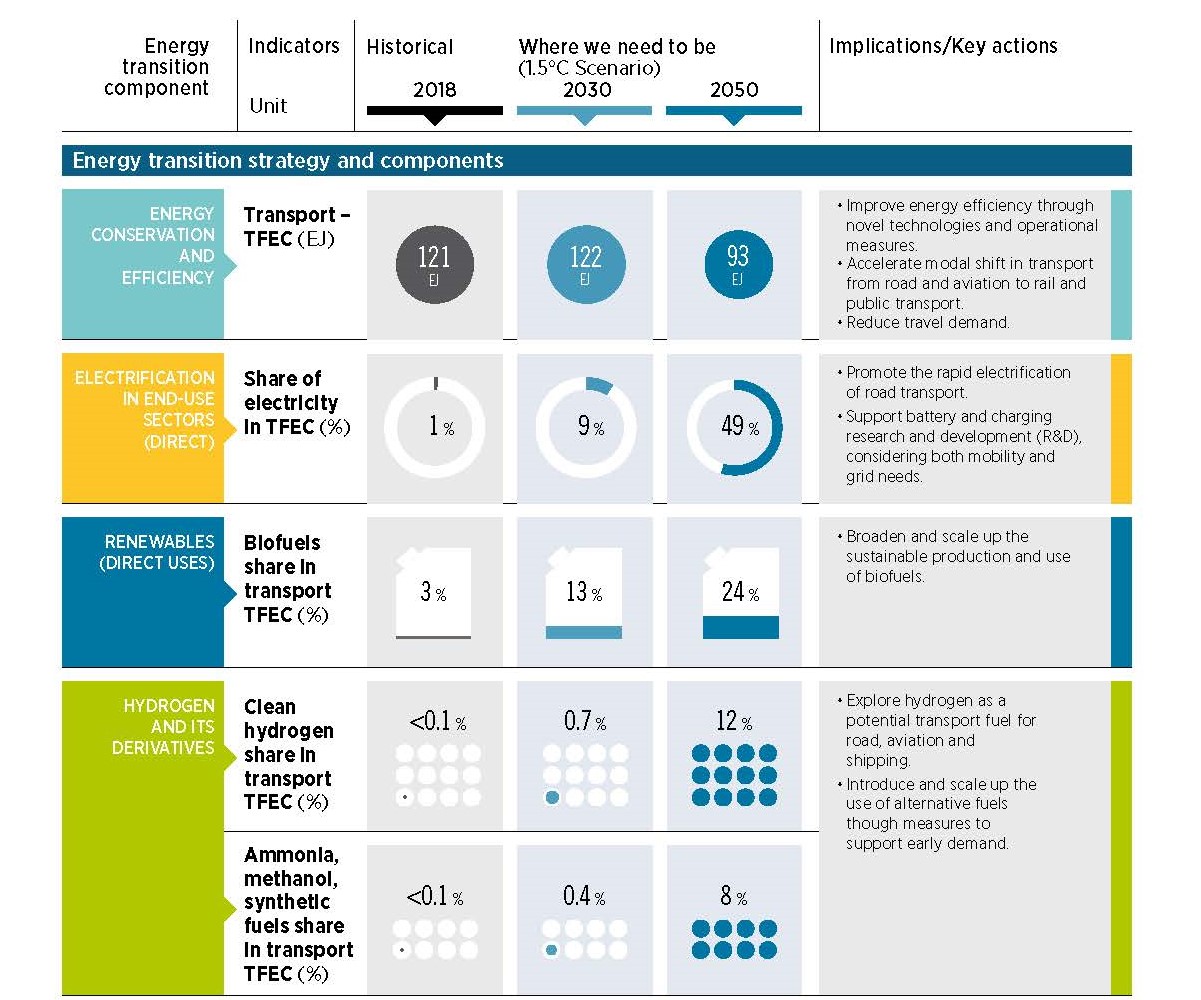Overview
The transport sector is responsible for close to a quarter of global energy-related CO2 emissions due to its heavy reliance on fossil fuels. With the global demand for transport services expected to increase in future years, it is crucial to sustainably transform the sector and advance towards a zero-carbon sector with renewables providing a large share of the solutions.
Transport sector decarbonisation
IRENA supports countries in defining strategies for effective decarbonisation of all modes of transportation, including land, air and maritime based, with available and emerging renewable options.
In a 1.5°C Paris Agreement aligned scenario, IRENA would foresee that:
- Transport would see accelerated electrification and an associated deployment of charging infrastructure in the coming decades. The share of electricity in final energy consumption would rise from 1% in 2018 to 49% by 2050. Electric vehicles (EVs) would account for more than 80% of all road transport activity by 2050. Such a transition implies that close to a third of all light-duty vehicle sales and a fifth of truck sales over the current decade to 2030 should be electric.
- Total liquid biofuel production would need to grow almost five-fold by 2050, contributing 25% of the overall energy demand in the transport sector.
- Hydrogen and its derivatives would offer a solution to transport needs that are hard to meet through direct electrification, mitigating close to 2.2 gigatonnes of CO2 (GtCO2) emissions in the 1.5°C Scenario compared to the Planned Energy Scenario in 2050.
- A combination of energy efficiency measures and low-carbon approaches would reduce transport consumption from 121 exajoules (EJ) in 2018 to close to 94 EJ by 2050. Adoption of stringent efficiency standards for new cars and trucks can reduce cumulative emissions in road transport by an estimated 15 GtCO2 equivalent until 2050.
- Beyond technologies, innovative mobility services and a modal shift from passenger cars to public transport (electric railways or trams), and from trucks to electric railways in the case of freight, would need to be promoted.
The combination of energy transition options adopted in IRENA’s 1.5°C Scenario would lead to a drastic reduction in transport emissions from 8.2 GtCO2 in 2018 to 0.4 GtCO2 in 2050.
Energy transition strategy and components

E-vehicles
Transport accounts for about 30% of global energy use, making renewable transport crucial for a sustainable energy future and electric vehicles (EVs) hold the key to unleash synergies between clean transport and low-carbon electricity. Just as future transport must be increasingly electrified, future power systems must make maximum use of variable renewable energy sources.
IRENA’s Innovation Outlook: Smart charging for electric vehicles shows how smart charging for EVs minimises their load impact and unlocks the flexibility to use more solar and wind power.
Biogas, when sufficiently purified, can be used in place of fossil-based gas to drive natural gas vehicles (NGVs) or dual-fuel vehicles. Switching to biogas as vehicle fuel can reduce greenhouse gas emissions in the transport sector between 60% and 80% compared to fossil-based fuels like gasoline and diesel.
More information in the report on Biogas for road vehicles.
Shipping
International shipping is a key sector of the global economy, as much as 90% of worldwide trade is transacted via ocean going vessels. It comprises 70% of global shipping energy emissions. If the international shipping sector were a country, it would be the sixth- or seventh-largest CO2 emitter.
The sector is also one of the most challenging to decarbonise.
However, with the right plans and sufficient support, the decarbonisation of the international shipping sector is viable. The sector’s decarbonisation strategy must involve a combination of energy efficiency and renewable fuels.
The technology readiness of the renewable fuels suitable for international shipping as well as the options and actions needed to progress towards a decarbonised maritime shipping are discussed in detail in A Pathway to Decarbonise the Shipping Sector by 2050.
Aviation
Globally, the aviation sector is one of the largest emitters of greenhouse gases at 2% of total global emissions. The emission level is projected to double by 2050 if business continues as usual. To achieve early reductions in emissions during the 2020s and into the 2030s, plus deep reductions by 2050, the use of sustainable aviation fuels (i.e. fuels that have significantly reduced emissions compared to conventional jet fuel) will be essential.
The Biojet Fuels report provides a comprehensive study of biojet fuels as a decarbonisation option for the aviation sector with a focus of reaching zero in time to fulfil the Paris Agreement and hold the line on rising global temperatures.
Past Events
View more-
21-22 October 2019 Luxembourg, Luxembourg
IRENA at the Pentalateral Conference on Electromobility



















